First Battle of Vác (1849)
The Battle of Vác, fought on 10 April 1849, was one of two important battles which took place in Vác during the Spring Campaign of the Hungarian War of Independence between the Austrian Empire and the Hungarian revolutionary army. The battle was the starting point of the second phase of the Spring Campaign, during which the Hungarians planned to relieve the fortress of Komárom from an Austrian siege, and to encircle the Austrian forces headquartered in the Hungarian capitals of Buda and Pest.
| First Battle of Vác | |||||||
|---|---|---|---|---|---|---|---|
| Part of the Hungarian Revolution of 1848 | |||||||
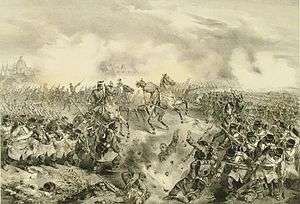 | |||||||
| |||||||
| Belligerents | |||||||
|
|
| ||||||
| Commanders and leaders | |||||||
|
|
| ||||||
| Strength | |||||||
|
Total: 11,592 men 36 cannons Did not participate: Detached troops from I. corps: 2973 men 20 cannons |
8,250 men 26 cannons | ||||||
| Casualties and losses | |||||||
| Total 150 men |
Total 422 men – 60 dead – 147 wounded – 215 missing or captured 1 battery[1] | ||||||
The Hungarians won the battle. The Austrian commander, Major General Christian Götz, was fatally wounded, dying shortly after the battle. His body was buried by the Hungarian commander Artúr Görgei with full military honors as a mark of respect.
Background
With the Battle of Isaszeg the Hungarian Revolutionary Army led by Artúr Görgei managed to force the Austrian Habsburg Imperial Army led by Field Marshal Alfred I, Prince of Windisch-Grätz to retreat towards the Hungarian capitals of Pest and Buda. This liberated the Hungarian territories between the Tisza and the Danube rivers. The imperial troops took up a strong defensive line before Pest.[2] The Hungarian commanders did not attempt to storm the position, but encircled Pest up to the Danube, and held in position until 9 April. The imperial army retreated to the capital.[3]
On 7 April a new campaign plan was made. According to this plan the Hungarian army was to split; General Lajos Aulich with the Hungarian II Corps and Colonel Lajos Asbóth’s division remained in front of Pest, demonstrating to make the imperials believe that the whole Hungarian army was there. This diverted their attention from the north, where the real Hungarian attack was to start with I, III and VII Corps moving west along the northern bank of the Danube to Komárom, to relieve it from the imperial siege.[2] Kmety's division of VII Corps was to cover the three corps's march, and after I and III Corps occupied Vác, the division was to secure the town, while the rest of the troops together with the two remaining divisions of VII Corps were to advance to the Garam river, then head south to relieve the northern section of the Austrian siege of the fortress of Komárom.[2] After this, they were to cross the Danube and relieve the southern section of the siege. If all this could be completed successfully, the imperials would have only two choices: to retreat from Middle Hungary towards Vienna, or be encircled in the Hungarian capitals by the Hungarians.[2] This plan was very risky (as was the first plan of the Spring Campaign too) because if Windisch-Grätz had discovered that only one Hungarian corps remained in front of Pest, he could have destroyed Aulich's force, and thereby easily cut the lines of communication of the main Hungarian army, and even occupied Debrecen, the seat of the Hungarian Revolutionary Parliament and the National Defense Committee (interim government of Hungary), or he could encircle the three corps advancing to relieve Komárom.[4] Although the president of the National Defense Committee (interim government of Hungary), Lajos Kossuth went to the Hungarian headquarters at Gödöllő, after the battle of Isaszeg and wanted a direct attack on Pest, he was finally convinced by Görgey that his and the other generals' plan was better.[5] To secure the success of the Hungarian army, the National Defense Committee sent 100 wagons with munitions from Debrecen.[5]
3.jpg)
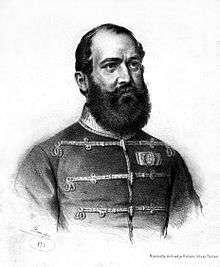
After the Battle of Isaszeg, Field Marshal Windisch-Grätz ordered the division quartered in Balassagyarmat to defend the Ipoly valley, led by Lieutenant General Georg von Ramberg, to move to Vác, to secure the Danube Bend from a Hungarian attack. But at the same time he made the mistake of ordering Lieutenant General Anton Csorich, who actually was defending Vác with his division, to move to Pest.[2] If two imperial divisions had been defending Vác when the Hungarians attacked, they would have had more chance of repelling them. On 10 April, when the Hungarian army planned to attack Vác, Görgey feared an imperial attack against his troops in the region before Pest. And indeed Windisch-Grätz ordered a general advance of his I and III Corps, to learn whether the Hungarian main army was in front of Pest or had moved northwards. But the Hungarian II Corps led by General Aulich, together with VII Corps and much of I Corps, easily repelled the attack.[6] At the same time, the deceptive maneuvers by Aulich and Asbóth managed to attract the attention of the imperials, who did not notice the march of III Corps, led by János Damjanich.[7] As a result, the field marshal was unable to obtain the information he needed. The inefficiency of the imperial reconnaissance is shown by the fact that on 12 and 14 April (4 days after the battle of Vác, when the main Hungarian army had already departed towards Komárom, and only II Corps remained there), Anton Csorich reported that Pest was in danger of being attacked by substantial Hungarian forces.[6] Aulich and Asbóth’s troops did their job of making the imperials believe that the main Hungarian army was still in front of the capital so well that neither Windisch-Grätz until his dismissal, nor Lieutenant Field Marshal Josip Jelačić (interim commander until the arrival of Feldzeugmeister Ludwig von Welden who was named as the new commander-in-chief), dared to do anything.[8] In contrast, the Hungarian reconnaissance was excellent, learning that Windisch-Grätz was still before Pest with three army corps awaiting the Hungarian attack, and that Ramberg’s division, composed of the Götz and Jablonowski brigades, was at Vác blocking the road to the Danube valley and to the Vág river.[9]
Prelude
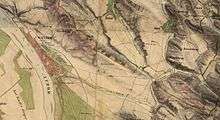
Because of the participation of VII Corps and much of I Corps in the skirmishes around Pest, the Hungarian army which moved towards Vác was composed only of III Corps and Lieutenant-Colonel János Bobich’s brigade of I Corps. The rest of I Corps only arrived at Vác after the end of the battle.[6] According to László Pusztaszeri (in 1984) the whole Hungarian I Corps joined the advance of III Corps towards Vác, but this is unlikely.[10] The military historian Róbert Hermann, writing 20 years later (2004) states that only Bobich’s brigade accompanied III Corps towards Vác.[11] They started to move north at 4 o'clock in the afternoon of 9 April, followed by VII Corps, which was extracted bit by bit from among the Hungarian forces performing the demonstrations.[7]
On the morning of the 10th of April, after his troops arrived at Vác, General Damjanich sent Bobich’s brigade of 2,973 men and 20 cannon through Rád and Kosd to encircle the imperial troops from Vác. But Bobich’s infantry lost their way in the fog and moved towards Penc (east instead of west), so his troops failed to appear in the battle.[12] At the last moment before the battle the imperial commander, Georg von Ramberg, fell ill, so Major General Christian Götz took command.[12] Windisch-Grätz had advised him to retreat west to the Garam (in Slovakian Hron) river without a fight if he faced superior numbers.[7] Götz’s men had not fought since the middle of February, being kept busy moving hither and thither in northern Hungary, in this aspect the battle-hardened Hungarian troops had the advantage.[12]
Battle
On a rainy 10th of April, Damjanich started his attack against Vác from the south at 9 o'clock, moving along the Pest-Vác road, because on that morning the fields were impassable due to wet weather. The road which led to Vác crossed the stone bridge over the Gombás creek, so Götz had posted his infantry on it.[13]
At this moment Götz was unaware of a serious Hungarian attack, thinking it was a numerically inferior force making a demonstration. Thus when he saw the Hungarians deploy their cannon, he only strengthened his outposts by sending his 2nd battalion to position itself along the Gombás creek, between the railway embankment and the Danube.[10] The battle started with an artillery duel, which lasted several hours. Damjanich deployed Czillich’s and Leiningen’s brigades on the left wing, and Kiss’s and Kökényessy’s on the right. He was waiting for Bobich to complete the encirclement of the imperial troops, but in vain. In the meanwhile Götz realized that he faced a numerically superior army, and at 3 o'clock in the afternoon, decided to start his retreat from the town.[10] He ordered his brigade commanders to withdraw from the city, but he wanted to hold the bridge until his troops were far enough from the Hungarians to be safe.[13]
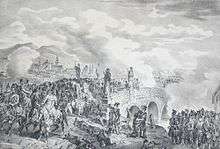
Seeing no sign of Bobich’s brigade in the enemy rear, Damjanich ran out of patience and ordered his infantry to charge the bridge, while his artillery fired incessantly. Götz saw his troops start to retreat from in front of the bridge because of the huge pressure from the Hungarians. He rode forward, yelling: "Advance, do not retreat!" In that moment he was hit by a shell splinter in his forehead, while his horse was taken down by at least ten bullets. The Austrian soldiers caught him as he fell, and took their wounded commander to the military boarding school in Vác.[14]
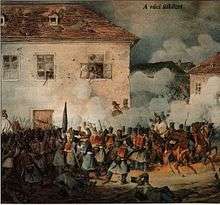
Wysocki’s division was the first to charge the bridge, but its several repeated attacks crumbled under the fire of the imperial kaiserjägers.[14] After its failure the 3rd and the 9th battalions, which were among the most renowned Hungarian units, came up to try, but the soldiers were not willing to risk their lives in a seemingly hopeless task. Then came to the scene the commander of the 3rd battalion, Major Károly Földváry, the hero of the Battle of Tápióbicske. He took the flag of his battalion and rode onto the bridge with it, under a hail of bullets from the enemy soldiers who occupied half of the bridge. His horse was shot dead in seconds, but he went back to his soldiers, took another horse and rode up the bridge again, and the same thing happened: the horse fell down beneath him in a second, but he remained unharmed. In that moment the imperial officer who was ordering the volleys was so astonished by this recklessness that he forgot to tell his soldiers to shoot, and in that moment the men of the 9th battalion arrived on the bridge and swept away the Austrian resistance.[14] After that the other Hungarian battalions also crossed the bridge, and in heavy street fighting pushed the imperials out of the city.[14] During this street fighting the Hungarians reached the building of the military boarding school where the wounded Götz lay, defended by the Bianchi infantry regiment. The Hungarians occupied it after heavy fighting, and found the Austrian commander inside, taking him prisoner along with many enemy soldiers.[14] The imperial troops which fought by the railway embankment withstood for an hour after the Hungarians crossed the bridge, preventing an encirclement of the imperial troops from the east, then they also retreated in heavy fighting.[10]
The imperial forces, now led by Major General Felix Jablonowski, retreated from Vác in heavy street fighting, heading towards Verőce.[14] The Austrian commander deployed two gun batteries, one of 12-pounders, the other of 6 pounders, and a rocket battery, to support his troops' withdrawal. His troops retreated in good order.[15]
Aftermath
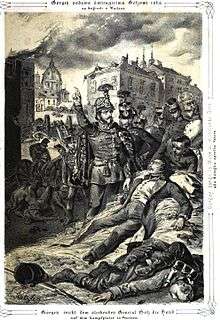
One of the Polish Legion’s medics took care of Götz's wounds. On 11 April Görgey arrived in Vác, and one of the first things he did was to visit Götz and ask how he was feeling. But because of his wound, Götz had lost his ability to talk, could not respond. His last wish was to be buried together with his ring. He received extreme unction from a Hungarian army chaplain, who prayed next to him until he died.[14] Götz was buried on 12 April, his coffin being carried by Hungarian soldiers on their shoulders accompanied by military music and drumbeat, in front of the Hungarian soldiers and the Austrian prisoners. The coffin was lowered to the grave by three generals: Görgey, György Klapka, Damjanich and a staff officer.[16] In 1850 Götz's widow showed gratitude for the care and respect paid to her husband by his enemies, by donating 2,000 forints to the military boarding school in which her husband had spent his last hours.[17]
From a tactical point of view, although they had lost their commander, the imperial defeat was not heavy, and the army could retreat in good order.[18] After the battle Damjanich was dissatisfied with the performance of some Hungarian commanders and units, believing that this battle could have been a more decisive victory. The irascible, impetuous general criticized the slowness of the cautious Klapka, who could have arrived at the battlefield in time if he had moved faster, and also General József Nagysándor, the commander of the cavalry, for the tardy pursuit of the enemy after the battle.[19] He also wanted to decimate the Polish Legion because they ran away after the first attack, but Görgey arrived and prevented this.[19] Damjanich was angry at the lack of exploitation of this victory, and of others before it in the Spring Campaign (Tápióbicske, Isaszeg), and he believed that the other commanders were responsible.[19]
With the victory at Vác, the Hungarian army opened the way towards the Garam river.[18] After the battle the imperial command in Pest continued to believe that the main Hungarian forces were still before the capital.[18] This was because only one corps participated in the Battle of Vác, which made Windisch-Grätz think that the rest of the Hungarian army had not yet arrived in Pest.[20] When he finally seemed to grasp what was really happening, he wanted to make a powerful attack on 14 April against the Hungarians at Pest, and then cross the Danube at Esztergom, cutting off the army which was marching towards Komárom. But his corps commanders, General Franz Schlik and Lieutenant Field Marshal Josip Jelačić, refused to obey, so his plan, which could have caused serious problems to the Hungarian armies, was not realized.[21] To hold back the Hungarian advance to the west towards Komárom, Windisch-Grätz, sent an order to Lieutenant General Ludwig von Wohlgemuth to stop them with the reserve corps formed from imperial troops from Vienna, Styria, Bohemia and Moravia. These troops would suffer a heavy defeat on 19 April by the Hungarian army in the Battle of Nagysalló, and with that the Hungarians opened the way to besieged Komárom.[22] But when these events took palace, Windisch-Grätz was no longer in Hungary, because in the meanwhile, on 12 April he was relieved of his command of the imperial troops in Hungary by the emperor Franz Joseph I of Austria. Feldzeugmeister Ludwig von Welden was appointed in his place.[22]
Notes
- Hermann 2004, p. 236.
- Hermann 2001, p. 282.
- Pusztaszeri 1984, pp. 269–270.
- Hermann 2001, p. 282
- Pusztaszeri 1984, pp. 282–283.
- Hermann 2001, p. 283.
- Pusztaszeri 1984, p. 287.
- Pusztaszeri 1984, p. 285.
- Pusztaszeri 1984, p. 286.
- Pusztaszeri 1984, p. 288.
- Hermann 2004, pp. 232–236.
- Hermann 2004, p. 233.
- Hermann 2004, pp. 232–233.
- Hermann 2004, p. 234.
- Pusztaszeri 1984, pp. 288–289.
- Hermann 2004, pp. 234–235.
- Tragor 1984, p. 148.
- Hermann 2004, p. 235.
- Pusztaszeri 1984, p. 289.
- Pusztaszeri 1984, p. 290.
- Hermann 2001, p. 284.
- Hermann 2001, pp. 285–289.
Sources
- Hermann (ed), Róbert (1996). Az 1848–1849 évi forradalom és szabadságharc története ("The history of the Hungarian Revolution and War of Independence of 1848–1849) (in Hungarian). Budapest: Videopont. p. 464. ISBN 963-8218-20-7.CS1 maint: extra text: authors list (link)
- Bóna, Gábor (1987). Tábornokok és törzstisztek a szabadságharcban 1848–49 ("Generals and Staff Officers in the War of Freedom 1848–1849") (in Hungarian). Budapest: Zrínyi Katonai Kiadó. p. 430. ISBN 963-326-343-3.
- Hermann, Róbert (2004). Az 1848–1849-es szabadságharc nagy csatái ("Great battles of the Hungarian Revolution of 1848–1849") (in Hungarian). Budapest: Zrínyi. p. 408. ISBN 963-327-367-6.CS1 maint: ref=harv (link)
- Hermann, Róbert (2001). Az 1848–1849-es szabadságharc hadtörténete ("Military History of the Hungarian Revolution of 1848–1849") (in Hungarian). Budapest: Korona Kiadó. p. 424. ISBN 963-9376-21-3.CS1 maint: ref=harv (link)
- Pusztaszeri, László (1984). Görgey Artúr a szabadságharcban ("Artúr Görgey in the War of Independence") (in Hungarian). Budapest: Magvető Könyvkiadó. p. 784. ISBN 963-14-0194-4.CS1 maint: ref=harv (link)
- Tragor, Ignác (1984). Vác története 1848-49-ben ("History of Vác in 1848–49") (in Hungarian). Vác: Váci Múzeum Egyesület. p. 544.CS1 maint: ref=harv (link)